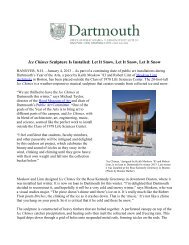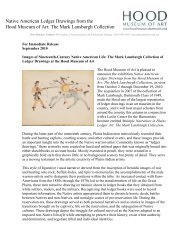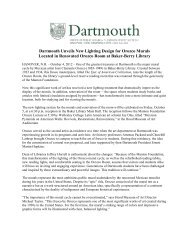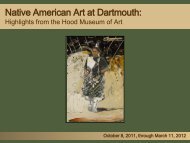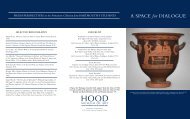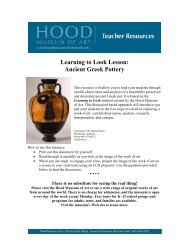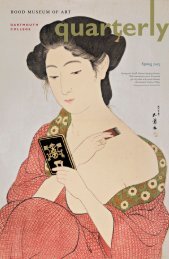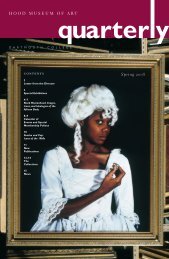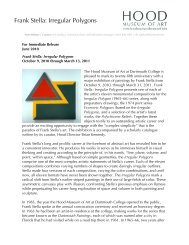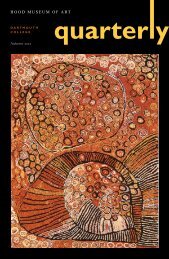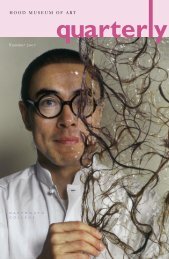The Great Age of English Mezzotints - Hood Museum of Art
The Great Age of English Mezzotints - Hood Museum of Art
The Great Age of English Mezzotints - Hood Museum of Art
- No tags were found...
Create successful ePaper yourself
Turn your PDF publications into a flip-book with our unique Google optimized e-Paper software.
Production, Distribution & Marketing<strong>of</strong> <strong>English</strong> <strong>Mezzotints</strong> in the Eighteenth Centuryt. barton thurber, curator <strong>of</strong> european artIn the century before the advent <strong>of</strong> lithographic and photomechanical reproductions inthe early 1800s, mezzotints were favored for publicizing <strong>English</strong> paintings. Comparedto traditional printmaking techniques, such as engraving and etching, this later tonalmethod was better able to represent the painterly qualities <strong>of</strong> light and shadow. Althoughgenerations <strong>of</strong> artists had used prints to promote their designs, the establishment <strong>of</strong>regular public exhibitions in London in the second half <strong>of</strong> the eighteenth century significantlyincreased popular demand for inexpensive and widely available editions <strong>of</strong> fashionable pictures.<strong>Art</strong>ists and collectors were equally attracted to the dramatic appearance <strong>of</strong> mezzotints.One particular example highlighted the appeal <strong>of</strong> the medium. Soon after Anthony VanDyck’s (1599–1641) painting <strong>of</strong> Paulus Pontius (fig. 3) arrived in England following its purchasein Amsterdam in 1763, the portrait was rendered into a magnificent mezzotint (fig. 2). It wasone <strong>of</strong> the first prints that James Watson (1739/40–1790) had independently published soonafter moving to London from his native Ireland to work for and train with his fellow countrymanand printmaker James McArdell (about1729–1765). Watson, whose prints were characterizedby a high degree <strong>of</strong> finish, quicklyestablished a reputation as a well-regarded andtalented artist. His mezzotint after Van Dyck’spainting was an extraordinary display <strong>of</strong> thequalities <strong>of</strong> a technique that had “introduced as<strong>of</strong>tness and delicacy before unknown inprints” (Chelsum, A History, 1786, p. 4). It alsounderscored the differences between the mezzotintand other reproductive techniques,especially since the composition had alreadybeen etched by Van Dyck himself after thesame picture in about 1630—seen in reversedue to the printmaking process (fig. 4). <strong>The</strong>primary distinction between the two methodswas summarized by William Gilpin(1724–1804), who wrote in his An Essay onPrints <strong>of</strong> 1768, “In etching . . . you make theshades; in metzotinto the lights” (p. 57).<strong>The</strong> traditional intaglio printmaking methodssuch as etching and engraving, in whichthe ink is deposited into the recessions <strong>of</strong> ametal plate, employ a system <strong>of</strong> lines to indicatetonal transitions from light to dark. In the caseFig. 3. Anthony van Dyck, Paulus Pontius, about1630, oil on canvas, 35⅞ x 25¾ in. Jerusalem, Israel<strong>Museum</strong>.5



